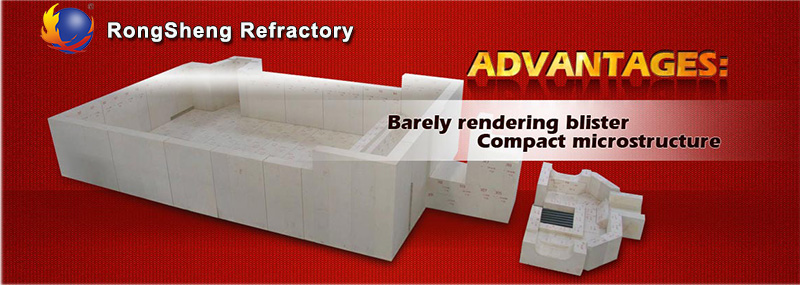Glass kiln cast refractory bricks are the most common refractory bricks purchased in glass kilns. The main technical indicators for assessment include chemical composition, bulk density, glass phase seepage temperature and quantity, and foaming rate. Other general refractory material inspection items such as porosity, refractoriness, and load softening point are not very meaningful for actual use conditions. During the condensation process of the ingot, due to the effect of the temperature gradient, chemical phase composition segregation will form along the cross section. This is a rule of cast AZS products. The higher the ZrO2 content and the larger the ingot size, the greater the degree of segregation. The ingot is generally divided into three parts:
- ① The surface rapid cooling zone: This zone has minimal deviation from the original design composition and features small, uniform crystals.
- ② The intermediate dense zone: ZrO₂ is enriched in this zone, where primary ZrO₂ crystals appear.
- ③ The internal shrinkage zone: This zone contains a large amount of liquid phase, allowing for the precipitation of large, stacked, and oriented (C+Z) particles.
Fused zirconium products are categorized by their chemical composition into: fused AZS, AZS re-sintered fused bricks, and fused zirconium mullite bricks.

Fusion-cast bricks for glass furnaces
AZS fusion-cast bricks, AZS No. 41 fusion-cast bricks.
AZS re-sintered fused bricks, AZS re-sintered fused bricks, are primarily used for masonry of thermal equipment such as the floor, walls, and regenerator checker bricks of glass furnaces.
Zircon-mullite fusion-cast bricks, whose primary mineral phases are mullite, baddeleyite, corundum, and glass phases. Their chemical composition lies within the triangular region of the Al₂O₃-SiO₂-ZrO₂ ternary phase diagram (approximately 63% Al₂O₃, 21% SiO₂, and 21% ZrO₂), where stable compounds are formed. The melting point of the mullite solid solution in this region is 1830-1870°C.
The main raw materials for making zircon-mullite fusion-cast bricks are industrial alumina, natural zircon, and a small amount of sodium oxide (in the form of soda ash). Some methods use raw bauxite, soft clay, and zircon to press into rough blocks. After firing, the blocks are crushed to a suitable particle size. MgO, a mineralizer, is then added during casting. The Al₂O₃/SiO₂ ratio should ideally be between 2.2 and 3.2.
Zirconium-mullite fused-cast bricks are characterized by a dense crystal structure, a high refractoriness under load, and excellent thermal shock resistance. They offer high mechanical strength at both room and elevated temperatures, excellent wear resistance, good thermal conductivity, and excellent resistance to slag erosion. They are used effectively in applications such as the cooling tank walls of glass melting furnaces.
Erosion Mechanism of the Slurry Hole, a Key Part of a Glass Furnace
The slurry hole is a crucial component of a glass furnace. Melted, clarified, and homogenized molten glass flows through it as it enters the distribution and supply manifolds, undergoing further homogenization and cooling before entering the molding equipment for production. Every day, 360 to 400 tons of molten glass pass through this narrow passageway, causing significant erosion and wear. Furthermore, the slurry hole operates in a harsh environment with high ambient temperatures, making it difficult to replace any problems. Therefore, fused AZS41# bricks or dense chromium oxide bricks (for some glass products) are highly corrosion-resistant for slurry holes.
Fused AZS bricks exhibit an upward pitting tendency at the interface between the solid, liquid, and gas phases. The fused AZS bricks are the solid phase, the molten glass is the liquid phase, and any bubbles remaining in the molten glass are the gas phase. The slurry hole cover bricks erode more than any other area, eroding upward by 300 to 400 mm in just 5 to 6 years. When the slit hole cover bricks erode by 300-400mm, the depth of the molten glass becomes shallower, equivalent to a 300-400mm reduction in the original kiln pool depth. This inevitably impacts the kiln’s discharge capacity. To meet this capacity, the furnace temperature must be increased, which in turn increases energy consumption. After a few years, the furnace cover and other components of the furnace body burn out, thinning the furnace body and increasing internal temperatures, further increasing heat dissipation.
In summary, the structure of the slit hole affects the kiln’s lifespan, discharge capacity, and energy consumption. To address the mechanism of slit hole cover brick erosion, the contact surface between the slit hole cover brick and the molten glass can be designed with an inclined design (upward angle of approximately 18°). This prevents bubbles in the molten glass from adhering to the slit hole cover bricks, significantly slowing erosion and extending the life of the slit hole, and therefore the kiln.

